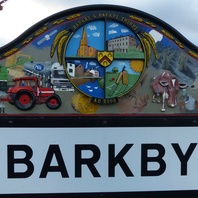
Viking Names
Barkby
Barkby, in the East Goscote Hundred of Leicestershire, is a Scandinavian compound from the Old Norse male personal name Bark, from either Barki (genitive singular Barka), or Barkr, Bǫrkr (genitive singular Barkar) combined with Old Norse by ‘a farmstead, a village’. A late form of the name, Mikeberkby, is prefixed by the Old Norse element mikill ‘great’ to distinguish it from its neighbouring daughter settlement Barkby Thorpe.
Read More

Blog Post
Viking Art Styles in the East Midlands: Borre
Traders, raiders, and artists? When Vikings are conjured in the popular imagination they clasp swords rather than chisels, but many of the Viking Age objects found in the East Midlands demonstrate intricate craftsmanship that still survives after a thousand years. Scandinavian art styles evolved throughout the Viking Age (c. 800-1100 AD) and are today classified into a loose chronology: Borre, Jelling, Mammen, Ringerike, and Urnes. These styles often overlap stylistically and chronologically, but there are enough distinctive features and recurring motifs to separate objects in various media into these identifiable styles. These art styles further developed in the British Isles with some objects retaining pure ‘Viking’ ornament or featuring a hybrid Insular style that slightly modifies Scandinavian features to fit a new social and artistic context. This blog series will briefly explore the characteristics of the Scandinavian art styles appearing in the East Midlands through the objects themselves. The Borre Style One of the earliest Viking art styles, the Borre style, was prevalent in Scandinavia from the the late ninth to the late tenth century. The style derives its name from group of bronze harness mounts discovered in a ship grave from Borre, Vestfold, Norway. The style is characterised by a range of geometric and zoomorphic motifs and the occasional gripping beast. The Borre Style in the East Midlands The Borre style came to England with the Scandinavian settlers from the late ninth century. The style proved to be popular amongst insular artists and appears on several forms of media such as stone sculpture and metal brooches throughout the British Isles. One object in the East Midlands that exemplifies the Borre style is a gilded, copper alloy equal armed-brooch fragment found in Harworth Bircotes, Nottinghamshire. There is a diagnostic Borre style beast with gripping arms and legs that has parallels with a find in Birka, Sweden. However, the gripping beast motif in England is quite rare as this brooch fragment is one of only six Scandinavian, Viking period equal-armed brooches recorded in England. A gilded, copper alloy equal armed-brooch found in Harworth Bircotes, Nottinghamshire with a Borre Style animal. Reproduction equal-armed brooch in the Borre style made by Adam Parsons Another copper alloy, gilded disc brooch in the Borre style found in Cossington, Leicestershire was probably brought to England from Denmark. The interweaving tendrils on this disc are characteristic of the Borre style and recall interlacing loops formed from gripping beasts. Scandinavian brooches tended to be domed with a hollow back compared to the English counterparts which were flat at the time. Borre disc brooch found in Cossington, Leicestershire The Borre style is not restricted to brooches in the East Midlands, it is also found on other objects such as this copper-alloy strap-end found in Brookenby, Nottinghamshire. Borre style strap-end found in Brookenby, Nottinghamshire The style is also found on a few buckles in the East Midlands including the copper-alloy belt fragment pictured below which is thought to be from a flat buckle. The object was found near Coddington, Nottinghamshire, and has few comparable examples. Another copper-alloy buckle was found near Earl Shilton, Leistershire. This buckle consists of an oval loop with a circular cross section and has an elongated triangular pin rest in the form of an animal head. The animal head has a pointed snout, rounded head with rounded upwards pointing ears which merge into the buckle loop. Copper-Alloy Buckle Fragment in the Borre style found near Coddington, Nottinghamshire A copper-alloy belt buckle in the Borre style found near Earl Shilton, Leicestershire All of these artefacts display the variety of isomorphic and geometric designs found within the Borre style and how this style was used to decorate different kinds of objects. The Ring Chain An instantly recognisable motif of the Borre style is the symmetrical, double contoured ring-chain. ‘This composition consists of a chain of interlacing circles, divided by transverse bars and overlaid by lozenges’ (Kershaw 2010, 2). Occasionally, the ring-chain terminates in an animal. The ring-chain appears in a modified ‘vertebral’ variant on stone sculptures in the British Isles where ‘a rib of truncated triangles’ is ‘flanked by side loops’ (Kershaw 2010, 2). The best-known example of the vertebral ring-chain is on the Gosforth Cross in Cumbria, but it is also found in the Isle of Man, Yorkshire, and even the East Midlands, engraved on a stone from St. Mary’s Church in Bakewell, Derbyshire. Borre ring chain design found at St Mary’s Church, Bakewell, Derbyshire © Roderick Dale References: Kershaw, Jane 2010. ‘Viking-Age Scandinavian art styles and their appearance in the British Isles Part 1: Early Viking-Age art styles‘, Finds Research Group Datasheet 42, pp. 1-7
Read More
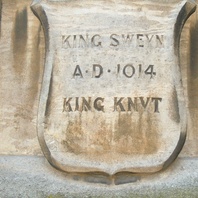
Viking Names
Svein
The Old Norse male name Sveinn was one of the commonest in Scandinavia, particularly in Denmark and Sweden, where it is recorded in many runic inscriptions. It occurs as the first element in the Lincolnshire place-name of Swinethorpe. Early forms of this name confirm that it is nothing to do with swine, but rather contains this name. The name continued in use in both Lincolnshire and Yorkshire well into the thirteenth century. It was famously the name of the father of King Knútr, later king of all England. Sveinn was known as ‘Forkbeard’ and died in Gainsborough, Lincolnshire, in 1014 according to the Anglo-Saxon Chronicle.
Read More
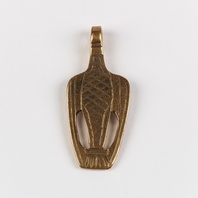
Viking Objects
Reproduction Bird Pendant
A reproduction bird pendant based on one found at Langford, Nottinghamshire. The nearest parallel to this type of brooch is one from Yaroslavl in Russia. The bird symbol, very similar to the one depicted on this pendant, was used by the Rurik dynasty which had started the conquest of Slavic lands in the mid 9th century and later formed the polity of Rus’. With some exceptions, pendants were generally worn by women as an accessory to Scandinavian dress.
Read More
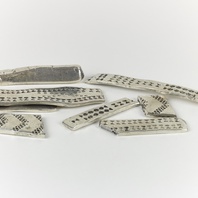
Viking Objects
Reproduction Hacksilver
These white metal reproductions of Viking Age hacksilver are typical of hacksilver finds. The Scandinavians had a bullion economy in the Viking Age and paid for goods by weight of silver rather than by using coins with a set monetary value. Arm rings are one example of wearable wealth that could be cut up to pay for goods when needed.
Read More
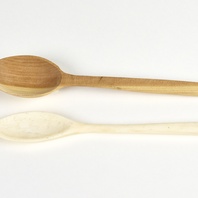
Viking Objects
Reproduction Wooden and Bone Spoons
Most ordinary people in the Viking Age would have used spoons made of bone or wood. These are typical examples of the types of spoons that people would have had. Wealthier people would have had copper alloy or silver spoons.
Read More

Viking Objects
Reproduction Wooden Bowls
Many everyday utensils would have been made from bone or wood. These photographs feature examples of wooden bowls.
Read More
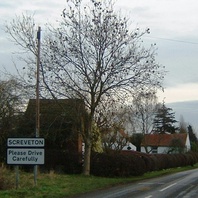
Viking Names
Screveton
Screveton, in the Bingham Wapentake of Nottinghamshire, is made up of two Old English elements, scir-gerefa ‘sheriff’ and tun ‘farm, settlement’. However, the modern pronunciation (as if ‘sk-‘) is due to the influence of Scandinavian-speakers. Old English words beginning in sc- (usually sh- in Modern English, like ‘ship’) often have Scandinavian equivalents spelled (and pronounced) sk- (like Old Norse skip and Modern Danish skib for the same thing). Many modern English words beginning in sk- derive from Old Norse.
Read More

Viking Objects
Reproduction Lead Gaming Pieces
Reproduction lead gaming pieces of a type commonly found across the East Midlands, including at the Torksey Viking camp. The reproductions are tin alloy while the originals were made of lead. These gaming pieces would have been used to play hnefatafl or Nine Men’s Morris, both of which are games known to have been played by Scandinavians throughout the Viking diaspora. It has also been suggested that these might have been weights.
Read More
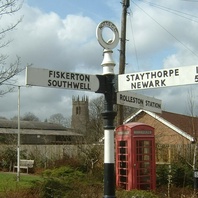
Viking Names
Fiskerton
Fiskerton, in the Thurgarton Wapentake of Nottinghamshire, is from the Old English elements fiscere ‘fisher’ and tun ‘farm, settlement’. The pronunciation has however been influenced by Scandinavian-speakers (compare Old Norse fiskari with the same meaning). There is also a Fiskerton in Lincolnshire, which has undergone the same process.
Read More

Viking Objects
Arabic Silver Dirham Fragment (SWYOR-1AE8AA)
This silver dirham fragment does not provide enough information to determine the ruler or moneyer but it seems to be from the seventh to ninth century. The dirham was a unit of weight used across North Africa, the Middle East, and Persia, with varying values which also referred to the type of coins used in the Middle East during the Viking Age. These coins were extremely prized possessions not only for their silver value but as a way of displaying one’s wealth and vast trade connections. Millions of Arabic dirhams would have been imported throughout the Viking world and are mostly found in hoards.
